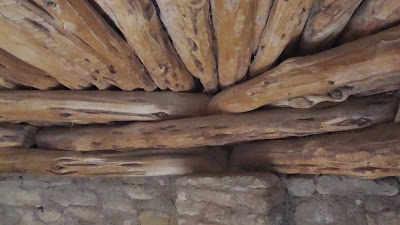 |
| The Grand Dad of Cliff Dwellings. |
Besides Juniper, there is also Pinion Pine and a breed of Mahogony trees that were insect resistant and served as floor and ceiling beams. You can see them as peeking dots in the distance.
The canyon falls steeply away from the palace.
A shot into one of the Kivas, which is a Hopi word. Who knows what the inhabitants actually called these places.
Like DIYs everywhere, the Indians continually built until 1284 A.D. (Evidence ends then.)
Judy peeking into one of the square towers, which are like four story apartment buildings.
What the camera saw when I aimed it up. Petroglyph art on the side wall.
This breed of oak is prolific. The natives used the acorns in various ways. Not much was wasted in the Pueblo world.
Judy climbing the last of three ladders out of the Cliff Palace, an altitude gain of about 800 ft.
A Kiva entrance at the Spruce House. Not sure if it's original or a recreation. Pretty cool either way.
Another look from the camera as I pointed it inside one of the tall apartments.
We got to climb down into this Kiva.
Inside the Kiva, the air vent for the fire and the deflection wall just behind the ladder.
The beams were interlaced to form the roof for the Kiva.
The housing groups contain several Kivas. It's unclear whether each family had its own, but we know from modern ancestors that these were places of religious significance. There are nine Kiva pits in the Cliff Palace, and every housing unit has them.
The petroglyph trail as it wound under the overhang. No complaints from the frickin' sixty-seven year old, but something was squeaking. I think it was her knees.
Amarillo leaves, a reminder that life is both delicate and short.
The view down the canyon from the middle of the Cliff Palace.
Just another natural rock formation. Below, the grooves in the sandstone were evidence of a tool sharpening station.
Way cool, and Yes!, it was worth the hike.
I know how this guy felt. We wound around, up, under, over, and down the canyon just to see him.
I couldn't photograph the whole panel, but it was a series of figures about ten feet square. I doubt my water colors will last this long. Maybe I'll start carving reliefs in stone.






















this is emily and sarah. we miss you. love you. love emily and sarah.
ReplyDeleteWe love you, too. Mucho Gusto!
Delete